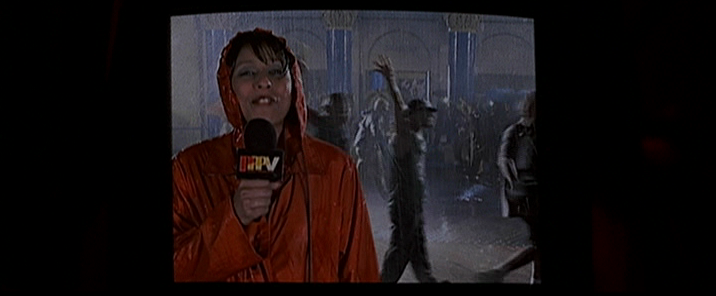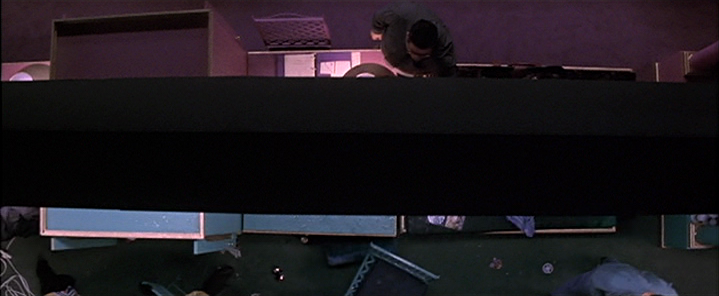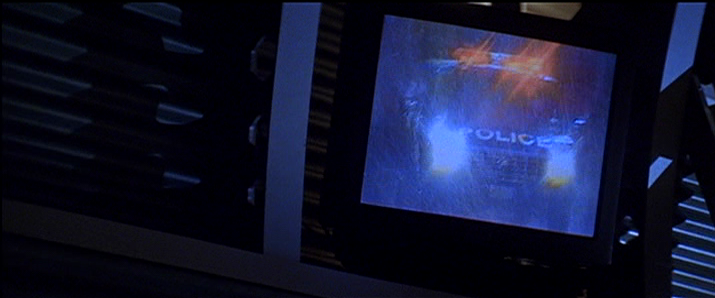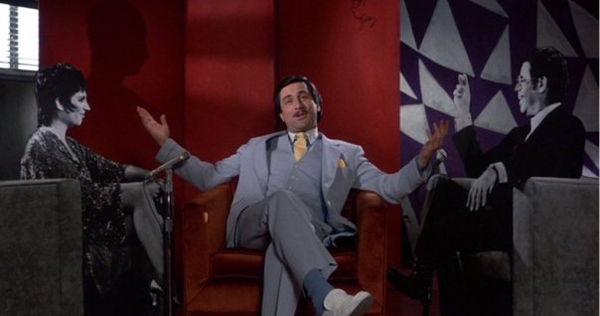Snake Eyes
Written by David Koepp
Directed by Brian De Palma
USA/Canada, 1998
Snake Eyes is not one of Brian De Palma’s bad films – and yes, he has a few; the man has been making films since the 1960s, of course he’s had some misfires. It pains me to read complaints about how ill-conceived Snake Eyes is, though. One can take little issue with someone claiming to dislike the film based on personal preference or a disdain for the subject matter, but it is unfair to base claims around how ineptly artificial and forced the whole thing is, as if punishing the film for failing to attain to some sort of authenticity. It’s a B-movie directed by Brian De Palma, starring a wildly over-the-top Nicolas Cage, and featuring not one, but two mind-blowing sequences. At what point does it need to be realistic and sincere? It’s a satire meant to expose America’s own artificiality – not some cookie-cutter police procedural with a whole lot of, you know, reality.
And it is certainly not evidence of De Palma putting style above everything else. De Palma rarely uses style just for the sake of it, as he always infuses the aesthetic with a sense of its own construction. De Palma knows movies, and many of his worlds are highly artificial on purpose. There is a reason Blow Out begins with a film-within-a-film, and there is a reason why Body Double is so ridiculously superficial. So when Todd McCarthy says that nearly every element in Snake Eyes is “contrived and almost laughably superficial,” I wonder why he thinks this is a bad thing (for the record, his review is tepid, not outright dismissive). De Palma has relied on expressionist imagery and self-reflexivity for most of his career, so why is it a problem with Snake Eyes? Were critics expecting a different sort of experience because of the genre? Either way, the issue seems worth delving into, if only to unpack false notions of the film being a waste of time.
Before getting started, though, I would like to acknowledge my debt to Robin Wood’s chapter on Alfred Hitchcock’s Marnie, a film that has also been unfairly criticized. In his rebuke of the criticism surrounding Marnie, featured in Hitchcock’s Films, Wood begins his analysis with a recap of what he calls “the main objections”. And since De Palma owes so much to Hitchcock, I figured why not borrow, reference and allude to someone I admire — so, I too will open with a list of objections, followed by what I see as counter evidence.
In a nutshell, the following seem to be the main objections (compiled from some of the more well-known critics at the time, among them Roger Ebert, David Denby, Todd McCarthy, Owen Gleiberman, and Jonathan Rosenbaum):
- The script is a constant let-down: elements show potential yet fizzle out; characters are one-dimensional; plot points are unconvincing and implausible, with everything being underdeveloped, as if merely a catalyst for De Palma and Stephen H. Burum’s visual ambition.
- Connected with this poor scripting and an emphasis on visuals, the film becomes unengaging: a moral thriller that never feels thrilling, due to an overriding sense of artificiality, not to mention, a painstakingly bad ending (literally everything about it).
- De Palma is simply showing off.
(The third objection will not require a reply, as my responses to the first two should lend themselves to any motivations De Palma may or may not have had for making Snake Eyes in the manner he did. And for what it’s worth, I fail to see any issues with an artist attempting to top the work of others – especially if he has the talent to pull it off. I’m referring to those who believe De Palma was simply trying to one-up the tracking shots from films like Touch of Evil and Goodfellas. I’m sure he was, but, as I stated earlier, his stylistic decisions are never without meaning.)
The two main objections are connected through shared implications of failure, claiming the film never maintains a sense of plausibility. It is important to note, however, that each reviewer takes time to praise and detail the technical virtuosity of the opening tracking shot, yet none of the reviewers offer insight into why De Palma opens the film in this manner. And only one of them mentions the first part of the sequence. Standing in the pouring rain, a news anchor explains how bad Hurricane Jezebel is, only to be interrupted by her producer: “You can’t call it that…they want you to say tropical storm.” And in the background, multiple young men are wearing t-shirts and jumping around, excited for ‘Fight Night’ and excited to be on TV, while wind and rain crash down around them. The news anchor’s response: “I love this town — they even spin the weather!” De Palma’s point: nothing in America is what it seems. Image is everything, money talks, and no one seems to care.
Todd McCarthy wrongly sees the aspect ratio of the opening as full frame, as he mentions: “with the image bursting dramatically into widescreen… [.]” Now, I know I’m being picky, but the aspect ratio is always in widescreen (until the end montage), as we are seeing the newscast through a monitor in the arena: a screen within a screen. And this is significant because our viewpoint is one that De Palma will keep referring to. Not only are we meant to reflect on what we are being shown, but also how and why we are being shown it.
The camera then slides past two other monitors, each showing an image from within and around the arena. On one, we are introduced to Rick Santoro (Cage) as he interrupts sports broadcaster Lou Logan (Kevin Dunn). When on camera, Rick is loud and obnoxious, yet when he and Lou step aside, Rick is calm (though still annoying). And a few seconds later when Rick’s girlfriend calls he is Mr. Smooth, and then he is Mr. Domestic when his wife calls right after. And if this isn’t enough, after watching Rick hassle a bookie and scream like an insane fight fan when seeing the heavyweight champ, we find out he’s a detective.
With Rick’s differing personas, De Palma is connecting him with the differing monitors at the beginning, and the differing vantage points we get when the assassination happens. And though the affiliation is heavy-handed and cynical, Rick can also be viewed as a stand-in for the American people. He is all surface, allowing consumerism and pleasure-seeking behavior to define his existence. So with this, yes, his character comes off as one-dimensional – but only on the surface; an ever-changing surface that De Palma is satirizing by suggesting that Rick never offers anything more.
Roger Ebert points out that the opening is “perfectly coordinated,” with high energy and an emphasis on excitement, yet fails to acknowledge the duality of this move. De Palma is not only making exciting cinema, he is also trying to mimic the build-up of ‘Fight Night’. For in American culture, there is this tendency to build excitement and energy no matter what the circumstances. Why? Because hype sells. Never mind that the fight could be an absolute dud—or fixed, as is the case here—what matters is having an environment of spectacle, a tendency Hollywood also never shies from.
Both Ebert and David Denby show disdain for the film not living up to the excitement of its opening, and I think this has more to do with their expectations than it does with De Palma losing grip on the material. (Ebert also has a history of disliking unreliable plotting; see his reviews for Fight Club and The Usual Suspects.) De Palma is showing how easy it is to get caught up in spectacle, and then he is doubling back (or better yet, quadrupling back) in order to break down what was really going on.
The opening unfolds in a perceived long take (technically, there are a few hidden cuts) because Rick has tunnel vision, and, by association, so do we. The implication is that we need to open our eyes (notice that the defining shot of the assassination comes from a blimp with an eyeball on it), and in this sense Snake Eyes shares many similarities with John Carpenter’s They Live, where seeing comes down to a change of perspective.
Now, in the case of an implausible plot, I whole-heartedly agree. The plot is ridiculous. From Commander Dunne’s (Gary Sinise) overly-complicated plan, to Julia’s (Carla Gugino) moralistic chivalry, the whole thing is preposterous. My favorite moment is Dunne’s explanation for the seeing-eye blimp: “We told them they couldn’t have a camera there.” ‘Umm, ok, so I guess you didn’t see it flying around then?’ And there are plenty more moments like this one. No character in the film behaves in any way that makes sense for the situation. In fact, in the current post-9/11 climate, the script would never be green-lit, and not solely because of the whole ‘American inside job’ angle, but because of how disorganized and inept the entire law enforcement and security personnel appear to be. For example, when Rick goes up to speak with the casino surveillance team, they act as if an assassination never occurred.
De Palma includes absurdities such as these, because, as stated earlier, the film is a satire. We are meant to reflect on how foolish everything is. Part of the enjoyment of B-entertainment is recognizing and enjoying artificiality, and De Palma is purposely mimicking American movies and American lifestyle. And he does so through the narrative, but he also does it through the aesthetic. Added to the amazing technical feats he and Burum pull off with the camera (that’s an entire article in itself), the set design and lighting of Snake Eyes utilize a sense of artificiality, whereby the constructed nature of cinema is used to comment on society. For example, in the bird’s-eye-view shot over the hotel rooms, it is obvious that the camera is moving over a film set. The shot is brilliant, and while it could be read as De Palma showing off, it can also be read as a critique of the self-absorbed nature of American citizens. We see four rooms, and in each of them none of the inhabitants seem overly bothered by the evening’s events. Their televisions are tuned into the news, but their attention is focused on sex, partying, or sleep; or in other words, they’re not going to let a murder and a hurricane ruin their evening. By drawing attention to the set and covering all of the rooms in one long take, De Palma infuses a sense of interconnectedness to the sequence, thus implicating the culture and not the individuals.
In his review, Jonathan Rosenbaum makes reference to those who champion De Palma’s B-movie style, but says the attempted moral outlook of the film over-shadows any success De Palma’s approach may have: “The hero’s moral regeneration — accomplished in less than two hours — is supposed to lend weight to the proceedings, but given De Palma’s floor-plan approach, the moral issues never seem very real.”
Rosenbaum has it wrong. Rick never goes on a classic moral regeneration. Yes, he goes out of his way to look after Julia, and yes, he turns down bribe money – but not because he has had a change of heart. Firstly, he wants the glory. Secondly, and more importantly, Rick wants to punish Commander Dunne—his supposed best friend—for using him and breaking his trust. Similar to many American citizens, Rick has blind faith in Dunne (who, in keeping with Rick as a stand-in for the American people, is then a stand-in for America itself). Therefore, Rick’s supposed moral path is all part of the satire; De Palma is taking aim at Hollywood films and the way protagonists always do the right thing, while also exposing the blind faith of American patriotism. And this is also why the ending is as corny as it is. De Palma drags out the final climatic scene in order to poke fun at the convenient, coincidence-ridden endings of many Hollywood thrillers, and Owen Gleiberman wrongfully calls him “the masturbator of suspense” because of it.
Notice how over-the-top the lighting in the sequence is. Lightening from the storm illuminates the space, with Rick and Dunne’s shadows taking center stage in the frame, the whole thing being wildly expressionist. Sure, the moment may lack suspense, but it does not lack ingenuity: a fake missile-like object somehow breaks through the wall (a bit of cheeky irony considering Dunne has laid everything on the line for a failed-defense system), Rick happens to look up at a random monitor showing police outside, and Dunne’s gunfire magically opens the door that will lead to his own death. There is just too much silliness (even for De Palma) to make me think the whole thing is meant to be taken at face value.
To add to the self-conscious absurdness, Rick is rewarded for his heroic behavior, only to be later punished and jailed for his previous corruption. With this, De Palma is again playing with genre conventions, and the same goes for Julia and Rick’s final meeting. With the two of them agreeing to get together after Rick is released from jail, De Palma is fulfilling the ‘good guy gets the girl’ trope. The bad guy is dead, the people are saved, and American/Hollywood ideals continue on as planned – everyone wins. Well not everybody. With the film’s final shot, the camera focuses on a group of construction workers sitting around on the job and then zooms in on a ruby—previously seen on the hand of one of Commander Dunne’s Navy officers before her murder—etched into a concrete pillar at the casino. With this final wink, De Palma further stresses his cynical views about American culture, heavy-handedly displaying America’s surface-level perspective.
— Griffin Bell















